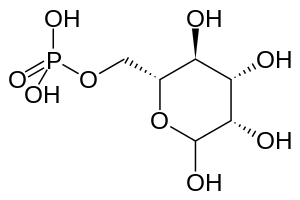Mannose 6-phosphate
Mannose-6-phosphate (M6P) is a molecule bound by lectin in the immune system. M6P is converted to fructose 6-phosphate by mannose phosphate isomerase.
 | |
| Identifiers | |
|---|---|
3D model (JSmol) |
|
| ChEBI | |
| ChemSpider | |
| MeSH | mannose-6-phosphate |
PubChem CID |
|
| UNII | |
CompTox Dashboard (EPA) |
|
| |
| |
| Properties | |
| C6H13O9P | |
| Molar mass | 260.136 g/mol |
Except where otherwise noted, data are given for materials in their standard state (at 25 °C [77 °F], 100 kPa). | |
| Infobox references | |
M6P is a key targeting signal for acid hydrolase precursor proteins that are destined for transport to lysosomes. The M6P tag is added to such proteins in the cis-Golgi apparatus. Specifically, in a reaction involving uridine diphosphate (UDP) and N-acetylglucosamine, the enzyme N-acetylglucosamine-1-phosphate transferase catalyzes the N-linked glycosylation of asparagine residues with M6P. Once appropriately marked with the M6P targeting signal, these proteins are moved to the trans-Golgi network. There, the M6P moiety is recognized and bound by mannose 6-phosphate receptor (MPR) proteins at pH 6.5-6.7.[1]
The M6P-tagged lysosomal enzymes are shipped to the late endosomes via vesicular transport.[1] Enzyme replacement therapy (ERT) for several lysosomal storage diseases relies on this pathway to efficiently direct synthetic enzymes to the lysosome where each can metabolize its particular substrate.[2] The pH in the late endosome can reach 6.0, which causes dissociation of M6P from its receptor.[1] Upon release, the enzymes are ferried to their final destination in the lysosomes.[1] The MPRs are packed into vesicles that bud off the late endosome and return to the trans-Golgi network.[1] In this way, the MPRs can be recycled.
References
- Alberts, Bruce; et al. (2002). Molecular biology of the cell (4th ed.). New York: Garland Science. ISBN 978-0-8153-3218-3.
- Coutinho, MF; Prata, MJ (2011-12-15). "Mannose-6-phosphate pathway: A review on its role in lysosomal function and dysfunction". Molecular Genetics and Metabolism. Elsevier. 105 (4): 542–550. doi:10.1016/j.ymgme.2011.12.012. PMID 22266136.
External links
- Mannose-6-Phosphate+Receptor at the US National Library of Medicine Medical Subject Headings (MeSH)
- Role of M6P in protein modification(video)